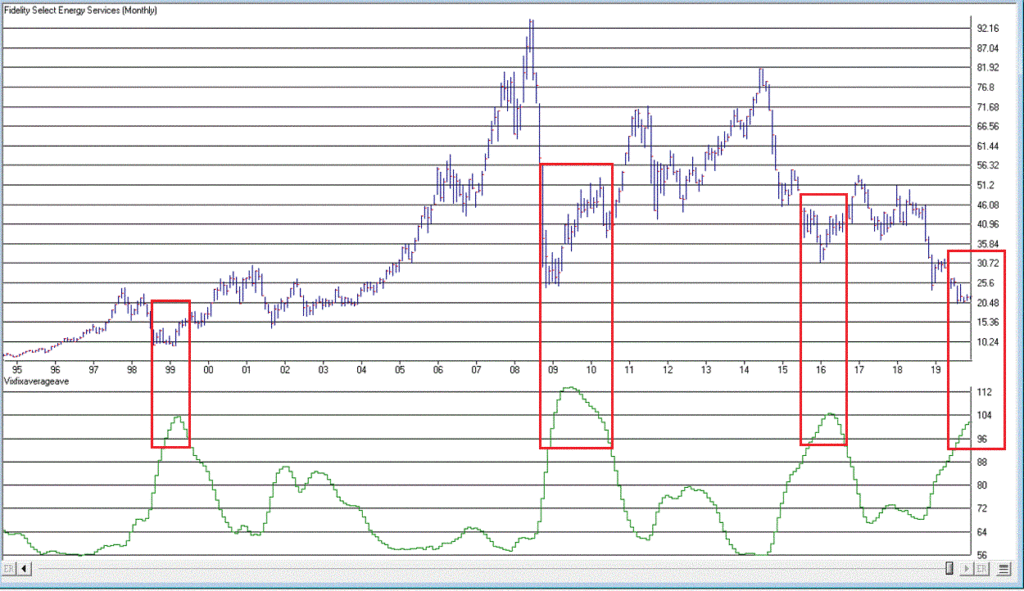I have been keeping an eye on energy stocks for quite awhile not. I wrote this article at the end of May wondering out loud if Halliburton (HAL) was nearing a bottom. At the time HAL was trading at $21.29 a share. It dropped as low as $16.97 (-20%) by the end of August. As of today, it is back up to $22.30. Is the bottom in in energies? No one can say for sure, but I have been reading from a lot of different sources about how much energies are loathed and beaten down and overdue for a bounce.
Of course, the more I read people saying that the more I wonder if it is still a little early. But to put things into perspective, Figure 1 displays Fidelity Select Energy Services with a custom indicator called “Vixfixaverageave” (I know, I know, bad name), which is basically a double smoothed version of an indicator called “VixFix” which was devised by legendary trader Larry Williams a number of years ago.

Figure 1 – Fidelity Select Energy Services (Courtesy AIQ TradingExpert)
Note that previous extreme peaks in the indicator have marked some fairly significant low areas for energy services. Given the current extreme reading for the indicator it would seem to make sense to be looking at now as a reasonable time to start allocating more to energy stocks.
Looking at Things on a Seasonal Basis
On a seasonal basis the month of December historically represents a very good time to be looking at energies. As it turns out, the energy services sector (and the overall energy sector as a whole) is one of the most highly cyclical sectors around. Figures 2 and 3 tell you pretty much everything you need to know.

Figure 2 – FSESX Cumulative % return, December through April; 1985-2019

Figure 3 – FSESX Cumulative % return, May through October; 1986-2019
In Figure 2 we see that the cumulative total return for ticker FSESX only during the months of December through Apr has been +6,624% since 1985.
In Figure 3 we see that the cumulative total return for ticker FSESX only during the months of May through November has been a stunning (-94%) since 1985.
So, when do you want to hold energy related stocks?
Note that as divergent as these numbers are, there still are no “sure things” in the world of investing. Note that the Dec-Apr period has showed a gain 76% of the time on a year-by-year basis. So do not make the mistake of thinking that energy prices are sure to be higher 5 months from now.
Likewise, note that the May-Nov period has showed a gain 44% of the time. So, despite the massive cumulative loss over time, remember that on a year-by-year basis it is almost a coin flip.
Summary
The energy sector has been beaten down and has remained down for a number of years. Broad based energy proxies such as ticker XLE and ticker FSENX both topped out in 2014. Ticker XLE is presently trading at the exact same level it was at roughly 13 years ago. So yes, the energy sector does qualify as a bullish contrarian play at this point.
The only problem is no one knows for sure when or where the bottom is. So, what is an investor to do? Given the seemingly “washed out” nature of the sector itself and the fact that it just entered it’s “bullish seasonal period” it may be a decent time for a long-term investor to consider establishing a position in the energy sector in anticipation that it will perform better overall in the years ahead – and more specifically in the months ahead.
Just remember that there are no sure things and that you must likely be prepared to “ride it out” for a period of time to reap any rewards. Given this, also remember that position sizing is of critical importance – i.e., “dip a toe, don’t bet the ranch.”
Jay Kaeppel
Disclaimer: The information, opinions and ideas expressed herein are for informational and educational purposes only and are based on research conducted and presented solely by the author. The information presented does not represent the views of the author only and does not constitute a complete description of any investment service. In addition, nothing presented herein should be construed as investment advice, as an advertisement or offering of investment advisory services, or as an offer to sell or a solicitation to buy any security. The data presented herein were obtained from various third-party sources. While the data is believed to be reliable, no representation is made as to, and no responsibility, warranty or liability is accepted for the accuracy or completeness of such information. International investments are subject to additional risks such as currency fluctuations, political instability and the potential for illiquid markets. Past performance is no guarantee of future results. There is risk of loss in all trading. Back tested performance does not represent actual performance and should not be interpreted as an indication of such performance. Also, back tested performance results have certain inherent limitations and differs from actual performance because it is achieved with the benefit of hindsight.

